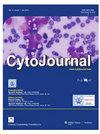利用相关免疫组化标记对临床可疑恶性肿瘤病例中的胸腔积液细胞块进行诊断分析
IF 2.5
4区 医学
Q2 PATHOLOGY
引用次数: 0
摘要
与胸膜活检相比,胸腔穿刺术创伤小、费用低,可采集样本进行细胞学评估。从这些样本中制备的细胞块可提供组织病理学诊断;此外,免疫组织化学(IHC)可对恶性肿瘤进行亚型分类,从而指导临床医生为患者选择合适的治疗方式。我们的目的是利用细胞块 IHC 确定恶性肿瘤的各种组织学亚型,并比较细胞块和传统细胞学诊断恶性胸腔积液的方法。这项前瞻性观察研究纳入了印度科塔亚姆政府医学院病理学系在 18 个月内收集的所有恶性肿瘤临床可疑病例的胸腔积液样本,重复样本和不足样本除外。本研究分析了 630 份样本,其中 121 个细胞块显示存在恶性肿瘤。总体而言,根据常规细胞学检查,分别有80%、13%和7%的病例为恶性肿瘤阴性、可疑和阳性;根据细胞块检查,分别有81%、0%和19%的病例为恶性肿瘤阴性、可疑和阳性。在所有恶性肿瘤中,肺腺癌(56%)最常见,其次是乳腺腺癌(6%)、鳞状细胞癌(5%)和卵巢腺癌(3%)。尽管两种方法的一致性一般,但细胞阻断术有助于发现的恶性肿瘤(19%)多于传统细胞学检查(7%)。腺癌是恶性胸腔积液最常见的病因,最常见的发病部位是肺部。与传统细胞学相比,细胞块有助于诊断更多的恶性肿瘤。本文章由计算机程序翻译,如有差异,请以英文原文为准。
Diagnostic analysis of pleural fluid cell blocks using relevant immunohistochemical markers in clinically suspicious cases of malignancy
Thoracocentesis is a less invasive and expensive procedure than pleural biopsy, enabling sample collection for cytological evaluation. Cell blocks prepared from these samples provide histopathological diagnoses; further, immunohistochemistry (IHC) can be performed for subtyping malignancies, guiding the clinician in choosing the appropriate treatment modality for the patient. We aimed to determine the various histological subtypes of malignancies using cell block IHC and compare the cell block and conventional cytology methods for diagnosing malignant pleural effusion.
All pleural fluid samples from the clinically suspicious cases of malignancy collected at the Department of Pathology, Government Medical College Kottayam, India, during 18 months, except duplicate and inadequate samples, were included in this prospective observational study. IHC was performed on cell blocks that were positive for malignancy.
This study analyzed 630 samples, of which 121 cell blocks demonstrated the presence of malignancy. Overall, 80%, 13%, and 7% of cases were negative, suspicious, and positive for malignancy based on conventional cytology, and 81%, 0%, and 19% were negative, suspicious, and positive for malignancy based on cell blocks, respectively. Among all malignancies, adenocarcinomas from the lung (56%) were the most common, followed by adenocarcinomas from the breast (6%), squamous cell carcinomas (5%), and adenocarcinomas from the ovary (3%). Cell blocks helped detect more malignancies (19%) than conventional cytology (7%), despite a moderate agreement between both methods.
Adenocarcinomas were the most common cause of malignant pleural effusions, and the most frequent site of origin was the lungs. Cell blocks helped diagnose more malignancies than conventional cytology.
求助全文
通过发布文献求助,成功后即可免费获取论文全文。
去求助
来源期刊

Cytojournal
PATHOLOGY-
CiteScore
2.20
自引率
42.10%
发文量
56
审稿时长
>12 weeks
期刊介绍:
The CytoJournal is an open-access peer-reviewed journal committed to publishing high-quality articles in the field of Diagnostic Cytopathology including Molecular aspects. The journal is owned by the Cytopathology Foundation and published by the Scientific Scholar.
 求助内容:
求助内容: 应助结果提醒方式:
应助结果提醒方式:


